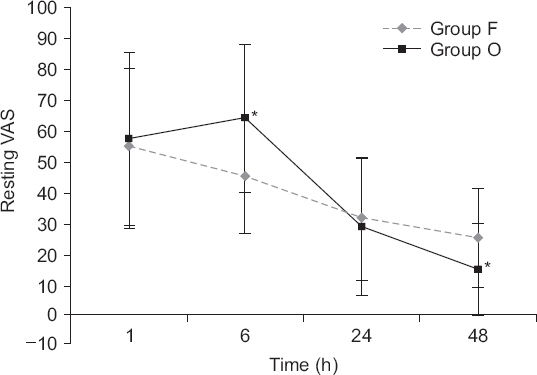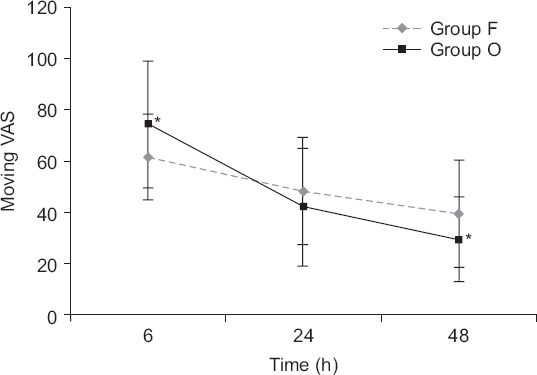Anesth Pain Med.
2018 Jul;13(3):271-277. 10.17085/apm.2018.13.3.271.
Comparison of oxycodone and fentanyl for postoperative patient-controlled analgesia after orthopedic surgery
- Affiliations
-
- 1Department of Anesthesiology and Pain Medicine, Daegu Fatima Hospital, Daegu, Korea. anji43@naver.com
- KMID: 2436034
- DOI: http://doi.org/10.17085/apm.2018.13.3.271
Abstract
- BACKGROUND
Oxycodone is widely used as bolus or patient-controlled analgesia (PCA) for control of postoperative pain. The aim of this study was to assess the efficacy and side effects of oxycodone for somatic pain by comparing oxycodone and fentanyl intravenous PCA after orthopedic surgery.
METHODS
Seventy-three patients undergoing orthopedic surgery were randomly assigned to receive fentanyl or oxycodone using intravenous PCA (potency ratio 1:60). Pain severity at rest and with movement and adverse effects were assessed at 1, 6, 24, and 48 hours after surgery. The PCA dose and patient satisfaction scores were measured at 48 hours after surgery.
RESULTS
The resting visual analogue scale (VAS) and moving VAS scores of the oxycodone group were significantly higher than those of the fentanyl group at 6 hours (P = 0.001, P = 0.021), but at 48 hours, the resting and moving VAS of the oxycodone group were significantly lower than those of the fentanyl group (P = 0.014, P = 0.037). There were no significant differences in adverse effects, satisfaction scores, dose of patient-controlled mode, or total cumulative PCA dose.
CONCLUSIONS
With a 1:60 ratio of oxycodone to fentanyl when using PCA for pain control after orthopedic surgery, the use of larger doses of oxycodone for 6 hours is effective in controlling early postoperative pain.
MeSH Terms
Figure
Reference
-
1. Baldwin K, Yannascoli SM, Namdari S, Spiegel DA, Keenan MA. What's new in orthopaedic rehabilitation. J Bone Joint Surg Am. 2013; 95:2071–7. DOI: 10.2106/JBJS.M.01037. PMID: 24257670.2. Bukata SV, Digiovanni BF, Friedman SM, Hoyen H, Kates A, Kates SL, et al. A guide to improving the care of patients with fragility fractures. Geriatr Orthop Surg Rehabil. 2011; 2:5–37. DOI: 10.1177/2151458510397504. PMID: 23569668. PMCID: PMC3597301.3. Joshi GP, Ogunnaike BO. Consequence of inadequate postoperative pain relief and chronic persistent postoperative pain. Anesthesiol Clin North America. 2005; 23:21–36. DOI: 10.1016/j.atc.2004.11.013. PMID: 15763409.4. . Guidelines for the management of postoperative pain after total knee arthroplasty. Knee Surg Relat Res. 2012; 24:201–7. DOI: 10.5792/ksrr.2012.24.4.201. PMID: 23269957. PMCID: PMC3526756.5. Pereira J, Lawlor P, Vigano A, Dorgan M, Bruera E. Equianalgesic dose ratios for opioids. A critical review and proposals for long-term dosing. J Pain Symptom Manage. 2001; 22:672–87. DOI: 10.1016/S0885-3924(01)00294-9.6. Silvasti M, Rosenberg P, Seppälä T, Svartling N, Pitkänen M. Comparison of analgesic efficacy of oxycodone and morphine in postoperative intravenous patient-controlled analgesia. Acta Anaesthesiol Scand. 1998; 42:576–80. DOI: 10.1111/j.1399-6576.1998.tb05169.x. PMID: 9605375.7. Staahl C, Dimcevski G, Andersen SD, Thorsgaard N, Christrup LL, Arendt-Nielsen L, et al. Differential effect of opioids in patients with chronic pancreatitis: an experimental pain study. Scand J Gastroenterol. 2007; 42:383–90. DOI: 10.1080/00365520601014414. PMID: 17354119.8. Staahl C, Christrup LL, Andersen SD, Arendt-Nielsen L, Drewes AM. A comparative study of oxycodone and morphine in a multi-modal, tissue-differentiated experimental pain model. Pain. 2006; 123:28–36. DOI: 10.1016/j.pain.2006.02.006. PMID: 16600508.9. Staahl C, Upton R, Foster DJ, Christrup LL, Kristensen K, Hansen SH, et al. Pharmacokinetic-pharmacodynamic modeling of morphine and oxycodone concentrations and analgesic effect in a multimodal experimental pain model. J Clin Pharmacol. 2008; 48:619–31. DOI: 10.1177/0091270008314465. PMID: 18440921.10. Sneader W. Drug discovery: a history. West Sussex: John Wiley, cop;2005. p. 119. DOI: 10.1002/0470015535.11. Sjövall S, Kokki M, Kokki H. Laparoscopic surgery: a narrative review of pharmacotherapy in pain management. Drugs. 2015; 75:1867–89. DOI: 10.1007/s40265-015-0482-y. PMID: 26493289.12. Pöyhiä R, Seppälä T, Olkkola KT, Kalso E. The pharmacokinetics and metabolism of oxycodone after intramuscular and oral administration to healthy subjects. Br J Clin Pharmacol. 1992; 33:617–21. DOI: 10.1111/j.1365-2125.1992.tb04090.x.13. Maddocks I, Somogyi A, Abbott F, Hayball P, Parker D. Attenuation of morphine-induced delirium in palliative care by substitution with infusion of oxycodone. J Pain Symptom Manage. 1996; 12:182–9. DOI: 10.1016/0885-3924(96)00050-4.14. Leow KP, Cramond T, Smith MT. Pharmacokinetics and pharmacodynamics of oxycodone when given intravenously and rectally to adult patients with cancer pain. Anesth Analg. 1995; 80:296–302. DOI: 10.1213/00000539-199502000-00016. PMID: 7818116.15. Backlund M, Lindgren L, Kajimoto Y, Rosenberg PH. Comparison of epidural morphine and oxycodone for pain after abdominal surgery. J Clin Anesth. 1997; 9:30–5. DOI: 10.1016/S0952-8180(96)00212-7.16. Koch S, Ahlburg P, Spangsberg N, Brock B, Tønnesen E, Nikolajsen L. Oxycodone vs. fentanyl in the treatment of early post-operative pain after laparoscopic cholecystectomy: a randomized double-blind study. Acta Anaesthesiol Scand. 2008; 52:845–50. DOI: 10.1111/j.1399-6576.2008.01643.x. PMID: 18477082.17. Kalso E, Pöyhiä R, Onnela P, Linko K, Tigerstedt I, Tammisto T. Intravenous morphine and oxycodone for pain after abdominal surgery. Acta Anaesthesiol Scand. 1991; 35:642–6. DOI: 10.1111/j.1399-6576.1991.tb03364.x. PMID: 1785245.18. Lenz H, Sandvik L, Qvigstad E, Bjerkelund CE, Raeder J. A comparison of intravenous oxycodone and intravenous morphine in patient controlled postoperative analgesia after laparoscopic hysterectomy. Anesth Analg. 2009; 109:1279–83. DOI: 10.1213/ane.0b013e3181b0f0bb. PMID: 19762758.19. Hwang BY, Kwon JY, Kim E, Lee DW, Kim TK, Kim HK. Oxycodone vs. fentanyl patient-controlled analgesia after laparoscopic cholecystectomy. Int J Med Sci. 2014; 11:658–62. DOI: 10.7150/ijms.8331. PMID: 24843313. PMCID: PMC4025163.20. Ding Z, Wang K, Wang B, Zhou N, Li H, Yan B. Efficacy and tolerability of oxycodone versus fentanyl for intravenous patient-controlled analgesia after gastrointestinal laparotomy: a prospective, randomized, double-blind study. Medicine (Baltimore). 2016; 95:e4943. DOI: 10.1097/MD.0000000000004943. PMID: 27684835. PMCID: PMC5265928.21. Park JH, Lee C, Shin Y, An JH, Ban JS, Lee JH. Comparison of oxycodone and fentanyl for postoperative patient-controlled analgesia after laparoscopic gynecological surgery. Korean J Anesthesiol. 2015; 68:153–8. DOI: 10.4097/kjae.2015.68.2.153. PMID: 25844134. PMCID: PMC4384403.22. Jung KW, Kang HW, Park CH, Choi BH, Bang JY, Lee SH, et al. Comparison of the analgesic effect of patient-controlled oxycodone and fentanyl for pain management in patients undergoing colorectal surgery. Clin Exp Pharmacol Physiol. 2016; 43:745–52. DOI: 10.1111/1440-1681.12586. PMID: 27128496.23. Gerbershagen HJ, Aduckathil S, van Wijck AJ, Peelen LM, Kalkman CJ, Meissner W. Pain intensity on the first day after surgery: a prospective cohort study comparing 179 surgical procedures. Anesthesiology. 2013; 118:934–44. DOI: 10.1097/ALN.0b013e31828866b3. PMID: 23392233.24. Kokki M, Broms S, Eskelinen M, Rasanen I, Ojanperä I, Kokki H. Analgesic concentrations of oxycodone--a prospective clinical PK/PD study in patients with laparoscopic cholecystectomy. Basic Clin Pharmacol Toxicol. 2012; 110:469–75. DOI: 10.1111/j.1742-7843.2011.00839.x. PMID: 22136407.25. Pesonen A, Suojaranta-Ylinen R, Hammarén E, Tarkkila P, Seppälä T, Rosenberg PH. Comparison of effects and plasma concentrations of opioids between elderly and middle-aged patients after cardiac surgery. Acta Anaesthesiol Scand. 2009; 53:101–8. DOI: 10.1111/j.1399-6576.2008.01819.x. PMID: 19032559.26. Choi BM. A new therapeutic option for postoperative pain management with oxycodone HCI injection. Korean J Anesthesiol. 2016; 69:211–8. DOI: 10.4097/kjae.2016.69.3.211. PMID: 27274364. PMCID: PMC4891531.27. Arendt-Nielsen L, Olesen AE, Staahl C, Menzaghi F, Kell S, Wong GY, et al. Analgesic efficacy of peripheral kappa-opioid receptor agonist CR665 compared to oxycodone in a multi-modal, multi-tissue experimental human pain model: selective effect on visceral pain. Anesthesiology. 2009; 111:616–24. DOI: 10.1097/ALN.0b013e3181af6356. PMID: 19672186.28. Khotib J, Narita M, Suzuki M, Yajima Y, Suzuki T. Functional interaction among opioid receptor types: Up-regulation of mu- and delta-opioid receptor functions after repeated stimulation of kappa-opioid receptors. Neuropharmacology. 2004; 46:531–40. DOI: 10.1016/j.neuropharm.2003.11.003. PMID: 14975677.29. Rivière PJ. Peripheral kappa-opioid agonists for visceral pain. Br J Pharmacol. 2004; 141:1331–4. DOI: 10.1038/sj.bjp.0705763. PMID: 15051626. PMCID: PMC1574907.30. Burton MB, Gebhart GF. Effects of kappa-opioid receptor agonists on responses to colorectal distension in rats with and without acute colonic inflammation. J Pharmacol Exp Ther. 1998; 285:707–15. PMID: 9580617.
- Full Text Links
- Actions
-
Cited
- CITED
-
- Close
- Share
- Similar articles
-
- Comparison of oxycodone and fentanyl for postoperative patient-controlled analgesia after laparoscopic gynecological surgery
- A new therapeutic option for postoperative pain management with oxycodone HCI injection
- Oxycodone versus Fentanyl for Intravenous Patient-Controlled Analgesia after Laparoscopic Gynecologic Surgery
- A comparison of oxycodone and fentanyl in the management of early postoperative pain and for patient-controlled analgesia after total abdominal hysterectomy
- A comparison of oxycodone and fentanyl in intravenous patient-controlled analgesia after laparoscopic hysterectomy



